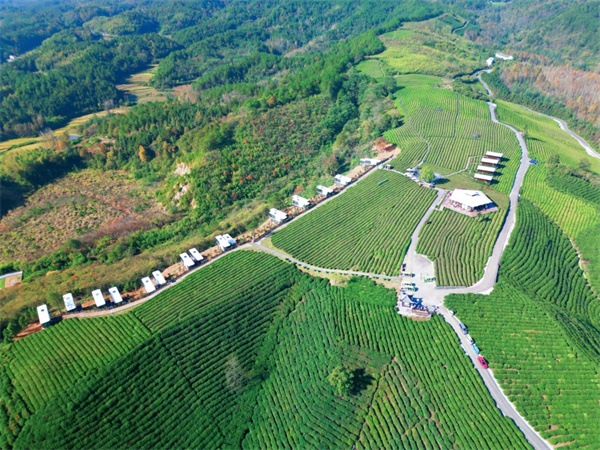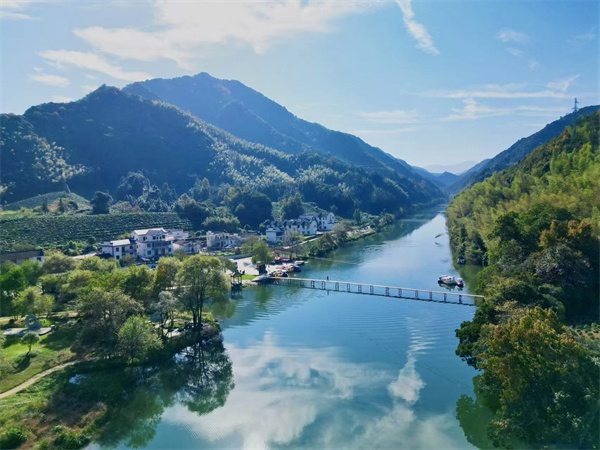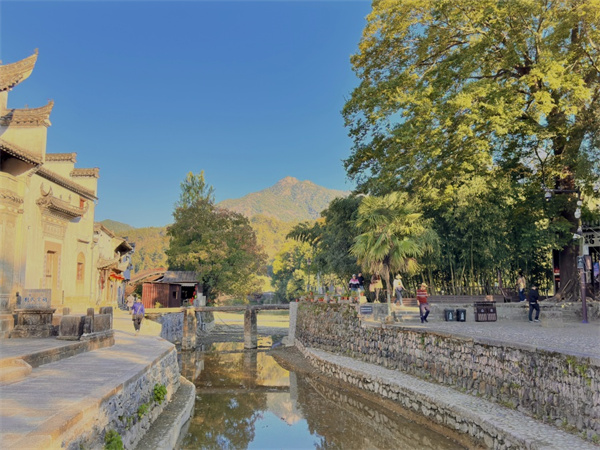
White capsule hotels are erected along the cusps of hills, along with a pentagonal tea house amid a tea garden. [Photo by Zeng Chen/For chinadaily.com.cn]
Vitalization is in the air in the Greater Huangshan Region — a lush area that encompasses cities of Huangshan, Chizhou, Anqing and Xuancheng in East China's Anhui province.
Huangshan Mountain, a UNESCO World Heritage Site since 1990, is a perpetual must-visit destination, greeting millions of vacationers every year. Smaller counties, sprinkled along the mountain range, are an idyllic, hilly paradise often overlooked by tourists but with plenty to offer.
Luxi village, in Xuancheng, is a hidden world of tea. The village of about 1,500 residents exports 40 metric tons of tea leaves to European countries annually. However, the agricultural village is dedicated to making itself more of a tourist destination.
The village now is the domain of nature lovers heading to its tea platform on the mountain summit. A ride uphill for 10 minutes gives tourists a view that is awe-inspiring: a calm and clean sky falls on mountains shrouded in thin mist, and an expanse of tea plants, maples and other trees stretches as far as the eye can see.
Beyond a perfect angle for photography, the village offers vacationers capsule hotels for views of scenery and stars, as well as a tea house that also serves a sip of latte, and a golden route for hikers to climb higher.
Cities in the Greater Huangshan Region are keen on promoting their "golden places" on social media platforms such as Xiaohongshu. Tourists flock to these places based on these internet advertisements and guides.

Tangjiazhuang village offers a pristine playground for water sports. [Photo by Zeng Chen/For chinadaily.com.cn]
The village considers itself to be engaged in a virtuous cycle. "The development of cultural tourism requires us to improve the rural environment, including sanitary conditions and infrastructure," said Jiang Feng, the village head. "So it also betters our villagers' lives in the meantime."
Huangshan district, Huangshan, is another top place to go. It is situated at the foot of Huangshan Mountain, but the tip of the mountain can be seen behind creamy clouds in the district's sunrise boulevards.
The district is close to almost every famous scenic spot in the region: Huangshan Mountain, Jiuhua Mountain and Taiping Lake. Tourists can have a natural expedition in the daytime but still enjoy a walk illuminated by neon lights in commercial strips.
The district is surrounded by counties and towns worth exploring. Tangjiazhuang village, in the tributary of Taiping Lake, is a wonderland for water sports lovers.
The limpid water mirrors the glassy sky and aquamarine hills, sheltering the village in pure tranquility beside the splash of paddleboards. The water suits both starters and pros. Tourists can check in at the village's exquisitely designed hotel and coffee house for a local air of rural vitalization.

A historical street between mountains basks in the sunset in Huangshan. [Photo provided to chinadaily.com.cn]
Renli village, an ancient Huizhou hamlet in Jixi county next to Huangshan Mountain, looks gold in a warm sunset. Its historical street winds past timeworn buildings, with wooden bridges stretching over the quiet river, shining as an ultimate example of Huizhou culture.
A platform for international communication is being established here. The village is learning from and exploring tourism markets in Japan, South Korea and Poland, while having received visitors from over 21 countries.
"Measures are coordinated for the development of the Greater Huangshan Region," said Hong Ting, deputy director of the culture and tourism bureau of Jixi county. "For now, we are building international-themed towns and facilities, attracting expats from nearby regions."

